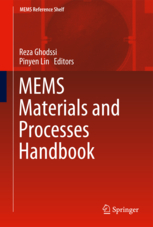Academic and industrial research scientists and engineers, as well as students working in micro-electromechanical systems (MEMS), commonly encounter a steep learning curve when developing common MEMS fabrication processes. A fundamental, comprehensive MEMS-focused reference book just published by Springer promises to be an important game-changing asset for the field.
The new MEMS Materials and Processes Handbook (ISBN 978-0-387-47316-1) pubished by Springer is an exhaustive design reference for researchers searching for new materials, properties of known materials, or specific processes available for MEMS fabrication. It will be valuable for seasoned researchers and engineers as well as students and other newcomers working in MEMS and materials processing.

The handbook is co-edited by Reza Ghodssi, Director of the Institute for Systems Research and Herbert Rabin Distinguished Professor in the Department of Electrical and Computer Engineering at the University of Maryland, College Park, Md.; and Pinyen Lin, Chief Technologist and Vice President of Business Development, Touch Micro-System Technology Corp. Taoyuan, Taiwan. It features 35 international contributing authors who are MEMS leaders in academic, industrial and government laboratory settings.
The handbook's content is separated into two distinct sections on materials and processes (fabrication techniques). In the materials section, the extensive "Material Selection Guide" and a "Material Database" take the reader through the selection of appropriate materials for the task at hand. The processes section of the book is organized as a catalog of microfabrication processes. Each entry contains a brief introduction to the technology, as well as examples of common uses in MEMS. The effects of processing conditions on material properties are covered where applicable, illustrating the interdependence and multidisciplinary nature of MEMS fabrication. There are also chapters on general MEMS design and MEMS process integration.
Unique feature: step-by-step fabrication recipes, tricks, arts and secrets
Not only does the book provide the reader with a broad understanding of materials and processes basics, it also gives practical insight into the daily workings and standard procedures carried out in research labs and production facilities.
As a particularly diverse and multidisciplinary field of research, MEMS presents a vast set of challenges relative to typical integrated circuit fabrication and design. While a wealth of knowledge exists in the MEMS community, much of it is accessed by informal, non-methodological means such as discussions with colleagues at conferences. Currently, researchers must spend valuable time on characterization runs and developing in-house recipes and specific processes to develop and manufacture MEMS structures, each time at the risk of wasting research efforts and "reinventing the wheel."
The handbook addresses this issue for the first time by including case studies at the end of each chapter with step-by-step examples and recipes prepared by seasoned MEMS experts. Readers will benefit from the identification and explanation of MEMS fabrication tricks, arts and secrets.
"The most important aspect of MEMS activities is the choice of materials, processes, integration and fabrication of complex homogenous, heterogeneous and hybrid structures," co-editor Ghodssi says. "In addition to introducing the reader to micro/nano fabrication and materials, we have designed the book to emphasize the most difficult and practical issues researchers experience in the lab but often are hesitant to share with their colleagues at conferences and in publications."